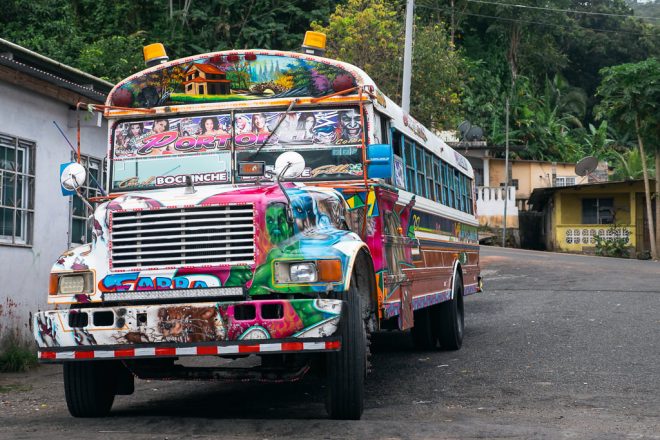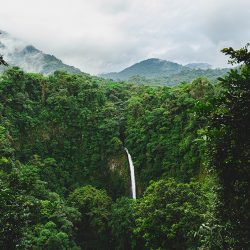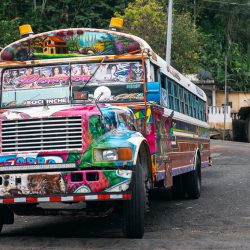(Updated Sep 2024)
If you’re planning a trip to anywhere in Central America, you’re undoubtedly aware that the region still has a bit of a bad reputation for safety. And this may give you pause when planning a trip there.
I admit I also had some reservations before I went traveling around Central America.
So, what’s the situation really like?
Based on my personal impressions while spending six months in Central America, but also speaking to numerous other travelers and locals about the security situation in many places, here are the key points that I found.
Is Central America safe to travel?
The stats don’t lie: crime levels are definitely higher in Central America than in many other parts of the world.
Of course, this also needs to be put into perspective, because these statistics may relate to places you might never go as a tourist. You are quite unlikely to hang out in, say, dangerous outer neighborhoods in cities. You are far more likely to do tourist things in tourist places where the safety levels are relatively higher.
While certain parts of Central America are far from a crime-free utopia, in reality you can still travel safely if you’re a responsible traveler. But it’s good to know the do’s and don’ts of travelling in this part of the world.
Here are a few tips for traveling safely in Central America.
Note: Even though it’s in North America, I will be including Mexico here, simply because it also often features in itineraries for this region and has similar safety concerns.
1. Most countries are quite safe
Central America has some known trouble-spots, but much of the region is quite safe. In fact, in several countries, I felt the situation is not all that different from other regions I’ve traveled, such as in Asia.
Based on UN crime statistics (as well as anecdotal evidence) it’s possible to make some rough distinctions between the different countries.
Firstly, Costa Rica, Panama, and Nicaragua have good reputations for safety. There may be some places here and there where travel guides or locals tell you to be a bit more cautious, but broadly speaking these countries are known to be reasonably trouble-free. If you’re a normal responsible traveler, then these countries aren’t worth worrying too much about. Of course, take care as you would anywhere in the world, and be mindful in the big cities.
The situation in Mexico is different in each state, but all the major tourist destinations are well-protected and should give little cause for worry. Baja California, the Yucatan peninsula, and Oaxaca are especially popular places for tourists and are also especially safe. While it’s a good idea to read the official travel advisories before visiting, Mexico is quite different from how some people (especially Americans) imagine it.
Phew, okay.
These countries do require a bit of extra care though:
Guatemala has much more of a serious problem with crime. One tell-tale sign is that it’s common to see armed security outside of banks. Anecdotally, I also heard of a number of travelers getting into issues here. Certain places are known for muggings after dark (like the viewing points in Antigua). To hike around Lake Atitlan, it’s often recommended to go with a guide who knows how to avoid trouble-spots. While I didn’t find Guatemala particularly threatening — it is, in fact, my number one favorite country in Central America — it also seems like a place where you shouldn’t be a mindless idiot, so to speak. Inquire locally about safety and maintain general awareness.
Finally, El Salvador and Honduras have by far the worst crime statistics in the region. Luckily, this relates mostly to the criminal underworld and has little to do with tourists. Nevertheless, I still felt that your movement as a traveler can be more limited here. (For example, I noticed that in Copan Ruinas people wouldn’t go on the street anymore after 9 P.M. or so.) El Salvador and Honduras do have a different vibe, and I’ve personally found myself approaching these countries with more caution than others.
(2024 Update: the security situation in El Salvador has improved hugely as the government jailed all suspected gang members. Now is your chance to see El Salvador while it’s much safer than ever before.)
2. Take care in the capitals
It’s best to assume that the capital cities will be a bit rough; Guatemala City, Belize City, Managua, San Salvador, etc. all have relatively poor reputations (though Panama City has a better reputation). Take official taxis at night and stay in a hostel/hotel in a good neighborhood.
Central America’s capitals also seem pretty dirty/chaotic/stressful, so your time is often better spent in smaller cities and the countryside anyway.
I think of the capitals mostly as transit hubs rather than key tourist destinations themselves. An important exception for me is Mexico City, which I feel is extremely culturally vibrant and has so many amazing museums. But other than Mexico City, the capitals are pretty underwhelming, so I don’t think you’ll be missing too much.
3. Use common sense
You may have heard the usual advice already, but: don’t wander the streets alone drunk at night, know which areas to avoid (if any), leave your passport and valuables in a hotel safe or hostel locker, and don’t openly show off any expensive items.
If using local so-called chicken buses (converted US school buses) keep a close eye on your stuff, as these buses tend to be packed with people and luggage providing potential opportunities for theft.
Take Ubers or official taxis. It’s better to have someone call a taxi than to grab one at random, as some taxis can be sketchy.
Be sure to get some travel insurance as this will give you support in case of accidents or theft.
4. Listen to locals
Knowledge is power! Ask the staff at your place of accommodation about the area and you will be immediately a little wiser. It will help you avoid trouble areas, but often this will also make you feel much more assured about areas that have a better reputation.
Knowing Spanish can help you raise your situational awareness and increase your ability to get help or information from locals. If you are going to spend some extended time in Central America, it pays off to learn some Spanish. This will also obviously enhance your cultural experiences — you’ll find that the locals are often very friendly and curious and want to talk to you.
Do you have insurance?
Travel insurance won’t in itself help you stay safe, but it can minimize the risks of travelling. With an insurance policy, you’ll be covered you for medical expenses, theft, personal liability, cancellation, and more. I recommend Heymondo, which offer flexible insurance for independent travelers with 24-hour worldwide assistance through their own app.
5. Don’t get too paranoid
I know that by talking about safety, it’s already possible to make you worry needlessly. But what you’re no doubt going to find is that shortly after you’ve arrived in your destination, you’re going to ease into the experience. Soon you’ll wonder what you were worried about at all.
Before I first went to Central America, people just kept telling me to “be safe”, which eventually got to my head a little bit, despite the cheerful reassurances from a friend who’d already been.
Keep in mind that the people who often have the strongest opinions on the topic are the ones who have never actually been. Watching some edgy Vice documentary on the dark underbelly of some place or other will not tell you anything useful about what it’s like to travel somewhere as a tourist.
Be sure to avoid outdated information as well. The security situation has improved a lot in many places. What an old second-hand travel guide tells you may no longer be accurate at all.
I spent about 6 months in Central America without any issues. People were very welcoming and friendly everywhere. But I do also know — through people I’ve met and the word in the travel community — that Central America isn’t exactly a crime-free utopia. Don’t be naive because serious crime does occur, and it’s obviously wise to travel in a sensible manner.
That’s probably the most balanced thing you can say on the matter. Central America may not be quite as safe or as easy as Southeast Asia or Europe, but the situation on the ground will probably be a lot better than you imagined. Make sure you’re adequately informed, but don’t let Central America scare you! It’s a truly amazing part of the world to travel.
Some links may be affiliate links, meaning I may earn commission from products or services I recommend. For more, see site policies.







Hey Marek,
Super info and tips about the safety in CA. I am planning a trip through and into S. America, and after some research safety seems to be my biggest concern. As an American, the news portrays this area as horrifying and a place no one should go. It seems any covered story is surrounded by death. Did you run into any experiences or people, especially tourists, who were genuinely scared for their life?
Thanks
Hey Brian. It can definitely seem that way from the media, but from a tourist point of view I think the reality is far more nuanced and much less alarming.
Since you asked, I have heard of one experience where a tourist was scared for his life (a guy I met in Guatemala). Though this involved a fight in a bar where the tourist chose to seriously escalate the situation. To be honest, I think he acted very irresponsibly and put himself in danger.
For tourists I believe the main issue to be wary of is petty crime.
Hi Brian, my 2 cents: You’re going to be fine if you keep your nose clean and keep your alcohol under control. The two biggest things that affect people’s safety in Central America are drugs and alcohol. Stay away from the drug scene and avoid excesses when you go out. You don’t want to be alone in deserted areas either (especially after dark). Additionally, set up a google alert for every country you intend to pass through between now and when you travel. This will give you a decent idea of what’s going on there and can tip you off to places and things to avoid.
Very good tips – I suspect drugs were a factor in the situation I mentioned above.
Anyone reading this should heed Rory’s advice. 🙂
Mexico is not part of Central America.
That’s geographically correct but as I mention elsewhere, it makes sense to group it together with Central America for travel information due to the cultural similarities and the fact that many people combine Mexico with Guatemala etc. I guess I forgot to mention that reasoning here.
Hey Marek,
Any thoughts on safety related to drinking water in Central America? Did you use a water filter, purifier, or hybrid filter/purifier? Or did you rely primarily on water bottles? I’m thinking it’s probably a good idea to invest in a water purifier that ideally filters and purifies (removes bacteria as well as potential viruses). What was your strategy for drinking water during your 6 months in Central America? Thanks for the helpful post!
Hey Jack. I think it’s best to drink bottled water. It’s available everywhere. No point in bringing purifiers unless you’re going to do multi-day wilderness hiking or something. If you’re going to be anywhere vaguely near civilisation, there’ll be safe bottled water around.
Useful comments! Here some updates. This past 2014 UN declared Nicaragua the 4th safest country in the Americas with a yearly declining crime rate of 12.4 per 100.000 lower than Costa Rica’s 13.7. Managua’s old downtown has been rejuvenated with more parks, squares, and unique amenities by Lake Xolotlan such as a miniature replica of downtown Managua before the earthquake of 1972; Malecon a historical lake promenade filled with restaurants and bars; Port Managua where boats take tourists to several idyllic destinations like Chiltepe Peninsula or Momotombo Volcano within short distance. Also the way is going in Europe, it’s probably safer to go out at night in Managua.
Hey Marek, nice summary of safety tips for Central America. You’ve probably noticed this as you come across people traveling, but unfortunately “common sense” when traveling isn’t as “common” as you might think when crossing borders into other cultures with differing expectations for keeping yourself and your property safe. I work with 50 – 100 North Americans a year traveling to Central America, and we constantly have to repeat the same messages:
1. Stay in groups and be extra alert if you’re off the beaten path, on desolate roads, etc: whether you’re exercising, visiting beaches, wherever… especially after dark
2. Don’t assume your stuff is safe if you leave it unattended or out of sight. Keep your eyes on it at all times. And a big emphasis on carrying a copy of your passport day to day instead of the real thing. Oh, and be discreet about your fancy things (Phones, tech, etc).
3. Take reasonable steps to avoid/lower mosquito bites. Dengue, Chikungunya, Zika, Malaria risks all significantly reduced if you can stock up on Deet.
My family got robbed big time in Costa Rica this past summer, so as a part of my “therapy” I put 20 tips down for travelers: https://commongroundinternational.com/immersion-in-costa-rica/street-smarts-in-central-america/
Great tips, Rory!
Hi
I’m looking at walking from Guatemala City to Panama City, as a solo woman. Any thoughts or advice?
Thanks
Jo
Hmm, not sure if I have advice for that. My experience in Central America is based on using public transportation or going on a road trip. I’m wondering if walking it solo is wise, but I might be wrong.
Don’t think is suggested to walk as solo, be it male or female, maybe you can have a group of people to do it with you but I believe is a wonderful experience if you have everything planned out.
Hey Marek, I love your articles. I was just wondering if you have any tips on vaccinations for traveling this area. I went to a US travel clinic and was lectured for 30 minutes about Malaria, Typhoid, and Yellow fever. It seemed very exagerated for liability reasons. I took the typhoid pills and decided to avoid Eastern Panama for Yellow Fever reasons. My question is do I really need to spend $400 on Malaria pills? Is it as much of an issue as they made it out to be? If so can I obtain effective ones for cheaper down there? The nurse also suggested a LOT of deet and clothing spray. My trip will be from March-June and extends from Mexico to Ecuador.
Hey Doug! So first the usual disclaimer: I’m not a doctor, but… 🙂
Malaria risk in Central America is actually very low and not much of a concern. It’s more prevalent in eastern Panama around the Darien gap and some parts of Colombia and Ecuador – mostly the remote Amazon, and the remote pacific coastal areas of Colombia (not really on the tourist trail). You can get useful maps from the WHO country profiles: http://www.who.int/malaria/publications/country-profiles/en/
My UK doctor advised me to only buy malaria pills locally in Colombia should I decide to go to such remote areas. I didn’t go to these parts and so didn’t take any malaria prophylaxis.
You can get a vaccination for Yellow Fever which will make you immune for 10+ years. You can also get a vaccination for Typhoid and you’ll be immune for 3+ years (and afaik these should be standard for travellers).
My personal view is that you’re probably right about liability. Precautions like mozzie spray with DEET are a good idea, but I personally wouldn’t take malaria prophylaxis in Central America, and only in some specific cases in South America. (Mainly if going to the interior Amazon region.)
Thank you so much for the advice! I am relieved to hear that from an experienced traveller.
Hello! I would like to share with you my experience, I was living in Central America for a couple of years, travel around and all that and during those years I never ever had any problem… the thing is that you must know the areas… I hardly see awful houses or anythings. I was in El Salvador for years and also in Costa Rica and I knew I had to avoid those dodgy areas in fact if noone would tell me the bad reputation of El Salvador I wouldnt know, really! I was living in San Benito and going to the Alliance Française each day during years and don’t see bad areas… lol
I think you are right when you say that the information we all know is from about 20 years or so… now i don’t think it is true at all…You just need to be smart.
I traveled Central America two years ago, and now have lived here a year. Mareks advice is very good. Here in Nica, most crime is opportunistic, and petty. No fancy watches, minimal jewelry if you look ‘gringo’. Also, I have a photocopy (laminated) of my info page of my passport. I carry it in lieu of my passport when I’m on the street. Do the same. Passports aren’t high value theft items, but a real pain to replace.
Lastly, coyotes (money changers) and supermarkets both give better exchange rates than banks, especially the ones in airports. Enjoy.
Thanks for sharing your experiences Keith!
Safety for women — watch what the local women who aren’t sex workers do. If they’re out at night, it’s pretty safe. I live alone in Nicaragua — no real problems after the first year where a Nicaraguan who’d hustled his way into a gringa’s life robbed her and got my keys and took things out of my house. I had, fortunately, not trusted leaving valuables in the house when I was away and he didn’t get what I suspect he’d come for.
I think traveling here during the day is pretty unremarkable. Don’t over dress, don’t flash valuables, pretty much the same rules as for the guys. Also, for everyone, watch out for kids as they see stuff on TV (which is very common here even among the poor) and we have it.
Speak as much Spanish as possible.
Hi, I really enjoy reading your blogs 🙂 I am heading to Central America for 5 weeks, I feel a little nervous as I will be a single female traveller but do you think this is fine as long as I don’t get into silly situations. Thanks
Hi, I’ve found your site to be extremely helpful. I note you did 6 months, I’d be very interested in the total cost of this? My boyfriend and I are considering a similar trip.
Thanks in advance.
Louise
I only kept a rough tally of my expenses, so I don’t have an exact number unfortunately. But it ended up somewhere around $6000. Some countries Costa Rica, Belize) are more expensive and others (Nicaragua, Guatemala) are much cheaper. But when it all evens out, I ended up spending around 1000/month. That’s by travelling backpacker style (hostels, local guesthouses) but occassionally doing more expensive activities (like scuba diving)
Awesome. Thanks for your help – I may be in touch again if we get the trip organised.